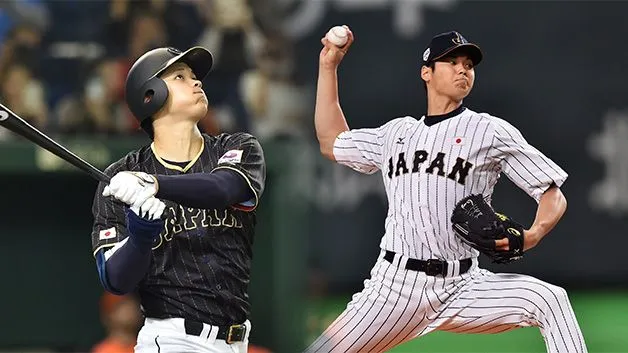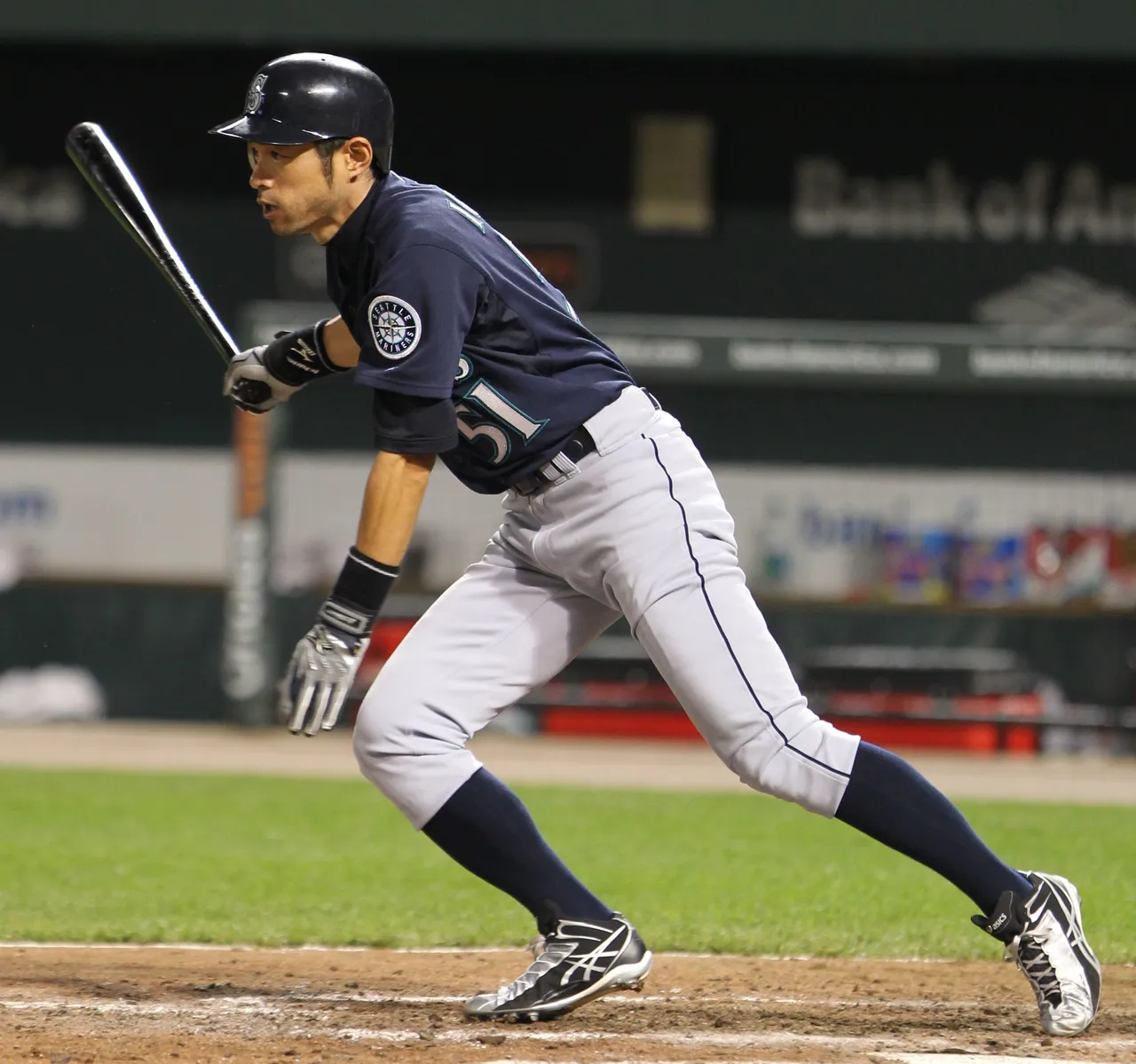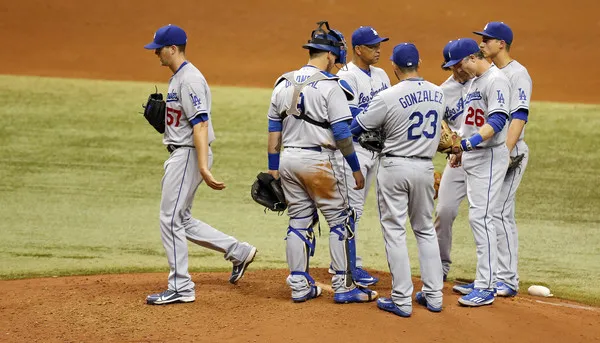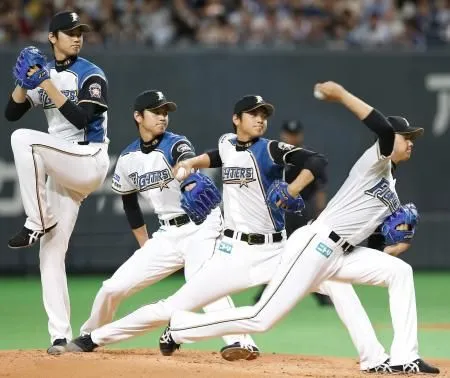Japanese baseball star Shohei Ohtani has announced his intention to play for a team in the United States. Having recently been posted via international rules, he’s now meeting with teams and will sign with one soon. He’s already eliminated several teams from contention, apparently having a preference for U.S. West Coast and small market teams.

Ohtani, hitting and pitching. (1)
As a two-way threat who can pitch AND hit effectively, Ohtani is a unique talent and will be a great boon to any team that signs him. According to most experts, his two-way skill set would work best on an American League team.
I think the experts are wrong and here’s why.
The Designated Hitter
Major League Baseball in North America has two leagues: the American League and the National League. Aside from one team in Toronto, Canada, all other teams are in the United States. And there is one key difference between the two leagues. In the National League, pitchers also must hit in the games they are pitching. In the American League, pitchers do not hit, and are replaced in the batting lineup by a designated hitter (DH).
The DH is a hitter who does not play in the field, so his only job is to hit when his spot comes up in the batting order. Most teams have power hitting DHs who may be older or less athletic than the players using their gloves on defense. Because pitchers focus on their craft rather than hitting, they tend to be poor hitters. In the National League, many pitchers are the closest thing to an automatic out. Meanwhile, American teams stock their lineup with that one extra good hitter.
Japanese sensation Shohei Ohtani has informed North American teams (yes, he has that bargaining leverage) that he wants to both pitch and hit. He’s widely seen as a great pitcher; how well his hitting will translate to the U.S. Major Leagues is another question. But because signing Ohtani would be a rare opportunity for any team to improve at a low cost, many teams in both leagues are ready to create the space for him to be a two-way player.

Some highlights from Shohei Ohtani's two-way play.
Experts predict that Ohtani will land in the American League. This is because he could play as a designated hitter (DH) on some days when he does not pitch. If he were to sign with a National League team, then his only batting opportunities would come from playing field positions on non-pitching days, meaning that teams would be letting him sacrifice his body running around the outfield to catch and throw the ball. That represents more risk than making him a DH and teams are very risk-averse when it comes to their top pitchers.
On paper, playing for an American League team would seem to give him the most hitting opportunities in addition to the pitching opportunities that any team is happy to provide.
But the National League Offers Better Opportunities
But I think conventional wisdom is wrong here. Perhaps Ohtani will sign with an American League team such as the Seattle Mariners, Anaheim (Los Angeles) Angels, or Texas Rangers (all of which are still on his approved list at the time of this writing). But I think the National League clubs make at least as much sense, possibly more.
Ohtani could excel in the National League for three reasons. First, the game is moving towards two-way players anyway. Other teams have drafted two-way college and high school players and they are open to developing these players now on both sides of the ball, so Ohtani will not be unique for very long. Anthony Gose (Texas Rangers), Brett Eibner (Los Angeles Dodgers), Brendan McKay (Tampa Bay Rays) and Hunter Greene (Cincinnati Reds) already are being developed as two-way players in those teams’ minor league systems. Soon, many teams (American and National) will have a process at the big league level for handling players who can both pitch and hit effectively.
Second, we don’t know how good a hitter Ohtani will be in the U.S. major leagues. His pitching should translate quite well; he throws 100 miles per hour and gets hitters out. But while we have seen a number of notable Japanese pitchers, only a handful of hitters/position players from Japan and other Asian countries have had any success in North America (with a bow to the great Ichiro Suzuki, perhaps the greatest pure hitter of all time).

Ichiro The Great. (2)
Even American League teams will be reluctant to promise Ohtani any substantial playing time as a DH. At best, he will share time at that position with one or more other players on any American League team. And if his power does not translate well to the new league, his new team will be reluctant to keep him in that role or give him many at bats, since he will be far more valuable as a pitcher who takes time to develop his pitching skills.
Third, Major League Baseball is changing in another way: top teams are taking their pitchers out of the games earlier. Except for top starting pitchers, and on teams that have poor relief pitching, we will see starting pitchers pulled out of games often in the Fourth, Fifth, or Sixth Innings of games now, as last season’s playoff teams were doing.

Dodgers Manager Dave Roberts Pulls Pitchers Early. (3)
In the stat-controlled world of baseball decision-making, there is a growing movement to prevent pitchers from having to face the same hitters for a third time in any game, since statistically, batters often adjust and perform much better after they have had 1-2 at bats against a particular pitcher. With nine hitters on each team and nine innings to play, more pitchers are getting yanked in the middle of the games now. The Los Angeles Dodgers were very careful about this in last year’s playoffs. In the previous year’s World Series, we saw both Chicago and Cleveland make early use of their bullpens. The New York Mets just hired a new manager partly because he has an interest in handling his pitching staff in a similar way.
(And this leads us back to the first reason above, since if pitchers are being used less, wouldn't it be nice if some of them also could hit well, making good use of that roster spot?)
Player Substitutions Add a Different Dynamic
And for a bonus fourth reason, when it comes to player substitutions, the National League reigns supreme. To avoid the pitcher’s (often ‘automatic out’) spot in the batting order, teams often make double-switches when the pitcher comes out of the game. This opens up different roles for players who are good pinch hitters (being brought in for one at bat to replace the pitcher or another batter) and for players who are good on defense and can enter the game late to help prevent the other team from scoring runs.
National League double-switching also is perfect for someone else: Shohei Ohtani. As a pitcher, he can hit for himself in the lineup. When he comes out of a game in favor of a relief pitcher, rather than removing him from the game, the manager can play some tricks and move him into the field. In addition, he can be brought into non-pitching games as a pinch hitter, potentially picking up many more at bats in clutch situations. And he would be valuable there whether he hits for power or for average (either one would be welcomed).

Shohei Ohtani Pitching. (4)
Contrast that with the American League where life would be a lot more boring. Ohtani would pitch every fifth or sixth day, he would play a few days as the DH, and if he does not hit for power, he would be benched in favor of a DH who can hit home runs. Where would his at bats come from at that point? Only in inter-league games in National League cities or in the odd pinch-hitting appearances.
I think Ohtani would have a lot more fun playing for a National League team. In the long run, he’d have the chance more consequential at bats there, especially if it turns out that he isn’t quite “The Japanese Babe Ruth” and can’t hit many home runs at the major league level. And consequential at bats, in addition to the pitching opportunity everyone is offering him, seems to be what he wants from this American experience. Should be fun to watch.
Sources:
Sports Day: https://sportsday.dallasnews.com/texas-rangers/rangers/2017/11/30/rangers-add-poor-mans-ohtani
MLB: http://m.mlb.com/news/article/262786764/shohei-ohtani-clearing-path-for-2-way-players/
Images:
(1) CBS Local, Boston
http://boston.cbslocal.com/
(2) Creative Commons via Flickr.com by Keith Allison
(3) Inside SoCal
http://www.insidesocal.com/dodgers/2016/06/01/dodgers-alex-wood-has-posterior-elbow-impingement/
(4) Bleeding Yankee Blue (sorry, Yanks fans, he isn't going to NY)
http://bleedingyankeeblue.blogspot.com/2017/11/thanksgiving-day-rumor-ohtani-is-on-way.html